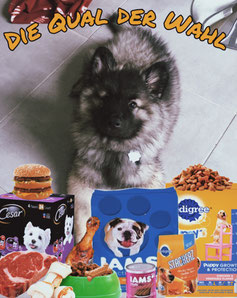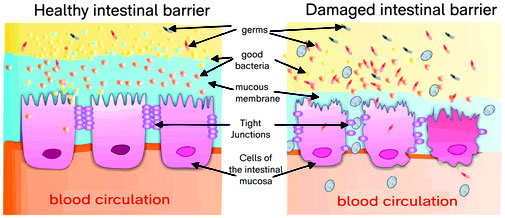About the dog's diet
How do I feed my German Spitz correctly?
So many opinions.....
Few things are as controversial in the dog world as the correct feeding of dogs. From vegan to BARF, every method that is conceivable is represented. Unfortunately, I find many methods to be just opinions that are based more on beliefs than on knowledge. Therefore, I tried to briefly sketch a circular argument from the dog's digestive system through the history of its domestication in order to show what the dog actually wants and should eat today.
Wolf and dog
The dog is descended from the wolf! This is the argument of many dog owners who feed their animals primarily meat today, and sometimes entire animals with fur and offal are offered for sale as food for the dog. However, the latest research has shown that dogs, unlike wolves, can also utilize carbohydrates. How closely related are wolves and dogs?
Man and dog
Fossil finds show that dogs have accompanied humans for at least 36,000 years. During this time, humans evolved from hunters and gatherers to shepherds and farmers, gaining the ability to utilize both lactose and starch (carbohydrates). The dogs that accompanied humans also adapted and are now able to digest starch, although this ability actually varies from dog to dog. Shepherd dogs, like their humans, live primarily on milk porridge and have up to eleven copies of an amylase enzyme, while Eskimo dogs, which eat only meat and fish, only have three copies of this enzyme. Therefore, one can generalize that the Greenland dog, for example, is closest to the wolf in terms of its eating habits and requires a very meat-heavy diet, while the herd guard dog gets along better with grain porridge.
What exactly did both species get out of it? The dogs certainly warned people of predators, while people's fires also provided warmth for the dogs in the cold winter and their waste and excrement made a tasty meal. Today we know that the human brain was only able to grow through cooking food and that this is how we were able to develop into Homo sapiens. Cooked food allows nutrients to be absorbed better and therefore provides more calories than raw food. Perhaps the consumption of cooked food made the development of the original dog into today's domestic dog possible? Surprisingly, both historical texts and research into indigenous peoples reveal that dogs have been fed primarily cooked food for thousands of years.
The historical diet of a dog
The latest outdoor studies show that dogs do not hunt like wolves, but rather eat like foxes or cats, wandering around alone and eating many small portions throughout the day. This dietary behavior was also supported by the results of the study on the risk of gastric torsion published by the University of Lafayette in 2004. It has been shown that feeding once a day doubles the risk of gastric torsion and even triples it in large dogs.
Dogs that only received dry food had the highest stomach weight, while those on a meat diet had the lowest stomach weight. The carbohydrate content of the food had no effect on gastric torsion; adding table scraps to the food significantly reduced the risk of gastric torsion. Canned food also reduced the risk, but not as much as feeding table scraps. Dogs fed a single type of food had a three times higher risk than dogs fed a varied diet. Basically, dogs have the same nutritional needs as humans: a varied and cooked diet is the be-all and end-all for a healthy life, because dogs have been our companions (and especially our table companions) for thousands of years.
Since the Greco-Roman period, we have had written evidence that provides information about the historical diet of dogs. It is reported from Roman times that the livestock guard dog should only be fed dairy products, as eating meat made them greedy. The observation that people made at the time was that a livestock guard dog fed meat proteins would become energetic, which would affect the dog's impulse control and tip it into hunting and protective behavior. Many historical evidence shows that over the last 2,000 years, both the dogs of princes and farmers were fed primarily with grain porridge or so-called "dog bread " based on flour and meal. Puppies, pregnant or sick dogs were given this bread to soak in milk or broth.
Proteins and carbohydrates
Why does the dog need protein and carbohydrates in its food? The body needs protein to maintain its body substance. The higher the demands placed on the body through performance, growth, pregnancy and illness, the higher its demands on the amount of protein it needs. As early as 1987, the influence of nutrition on the behavior of dogs was scientifically examined for the first time, and it was found that reducing the protein content in food leads to a clear reduction in aggressiveness.
Carbohydrates are the most important energy suppliers for humans and animals. The starch is broken down into glucose units, which are then supplied directly to the energy supply or are temporarily stored in the form of glycogen in liver and muscle cells or are used to produce fat. Glucose can easily pass through the blood-brain barrier and is therefore important for brain metabolism. Glucose is also of great importance for the metabolic use of the amino acid tryptophan, which is involved in the production of the happiness hormone serotonin. Serotonin inhibits impulsivity and aggression, and also protects dogs from anxiety and depression. This messenger substance cannot be produced without tryptophan. Dogs obtain tryptophan from meat components. Muscle meat contains more of it than bone meat. However, tryptophan can only cross the blood-brain barrier if carbohydrates are fed.
Dog's metabolism
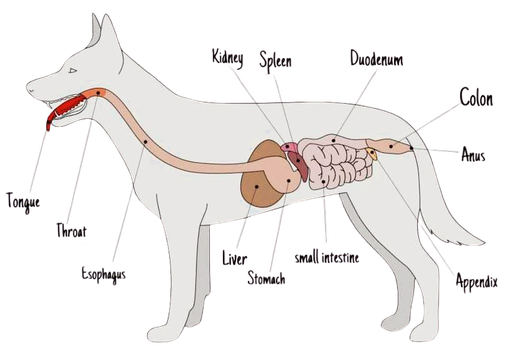
The dog's alimentary canal is approximately 5 to 6 times its body length. This means that the dog's intestine is relatively short compared to other animal species. The digestive tract is not proportional to the size of the dog, which is why smaller breeds have a larger digestive tract in relation to them. After the food is shredded, it is mostly digested by digestive enzymes, but sometimes also by bacteria in the large intestine. The stomach has an enormous ability to expand, so that a lot of food can be eaten at once. Hydrochloric acid secretion takes place in the stomach, which thoroughly kills germs and bacteria in the food. Therefore, dogs can also use carrion and waste without getting into major problems.
It continues in the small intestine. Large mucous membrane surfaces ensure that the maximum amount of nutrients from food is absorbed. The breakdown of the feed protein continues here, and carbohydrates and fats are broken down at the same time. Bile and pancreas help the small intestine to break down nutrients as intensively as possible. Due to inflowing gastric and intestinal juice, the food pulp in the small intestine is very liquid. If the small intestine becomes ill, severe digestive disorders usually occur.
A significant portion of the water present in the feed pulp is absorbed in the large intestine, so disturbances in this area can result in undesirably soft stool or diarrhea. There are bacteria in the large intestine that are responsible for further digestion. The oxygen content in the large intestine also decreases significantly, which, among other things, leads to the death of germs that need oxygen. The large intestine also provides the desired anaerobic living atmosphere for these intestinal bacteria.
Bacteria and the dog's organism live in mutual dependence on each other, the dog provides the living space and in return the bacteria shred some of the indigestible nutrients. And as long as this system is in balance, the dog has no problem. However, if the dog is fed mainly with low-quality proteins (slaughter offal rich in connective tissue, cartilage, tendons), the digestibility in the small intestine is much lower. Therefore, more of the dietary protein migrates to the large intestine. The bacteria present there multiply rapidly due to the oversized feast and can possibly spread into the small intestine. This not only reduces the animal's supply of amino acids, but also increases the formation of microbial protein degradation products such as ammonia and hydrogen sulfide, which have to be detoxified in the liver and thus place additional strain on the organism. So the dog-bacteria symbiosis has been masterfully derailed here.
What conclusions can you draw from this? The protein supply should therefore cover the needs, but should never be too high. You should also pay attention to high-quality protein. Unsaturated fats and carbohydrates can be added to the protein. Since starch is very well tolerated, it is an important energy source in dog food. In general, “too much” is never good. Milk is well tolerated, but if the amount is too high, too much of it will be digested in the large intestine and the system will tip over. The same applies to too much starch, too much protein and too many fats.
B.A.R.F.
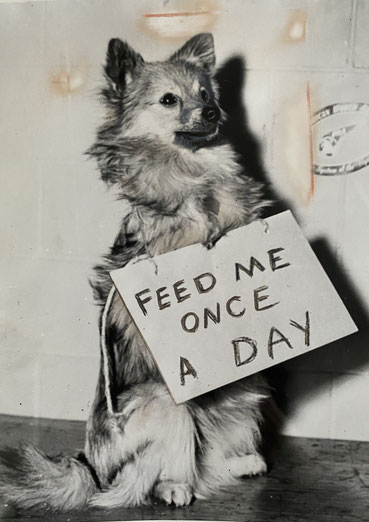
Unfortunately, many dog owners think that they have to feed their dogs like blood-drinking predators from prehistoric times, without recognizing that it has been scientifically proven that dogs are no longer wolves and that - unlike wolves - they can also metabolize carbohydrates very well. And also has to, so that he becomes full and satisfied. If you only eat meat, you won't be full. Sure, you lose weight very quickly and only a less poop comes out of it. However, I wouldn't want to live like that. Why? Because humans are omnivores. Just like dogs are omnivores. Dogs are neither pure carnivores nor vegans. They are also no garbage eaters or pure dry food eaters. It is also not better to feed them only from cans or only feed them raw meat.
Speaking of raw: BARF (" Bone And Raw Food ") is usually deep-frozen meat that is thawed when necessary. Unfortunately, this is often not done very professionally, so that flies may lay their eggs in the thawing meat and transmit fecal bacteria. What's more, Botulinum bacteria can form when the meat is thawed in the closed plastic packaging. This can result in chronic gastritis with stomach pain, stomach inflammation and diarrhea and bad flatulence. What is often referred to as food poisoning in humans also occurs. Serious symptoms of the disease can also occur a week to ten days after consumption. Even cooking does not completely kill these bacteria; only 90 percent of living pathogens are killed by cooking.
Even veterinary specialist organizations reject barfing because, on the one hand, the risk of the dog being under-supplied is quite high and, on the other hand, because it entails microbiological risks - for both animals and humans. Dogs that have often been bared excrete salmonella, among other things, which can then lead to infection in humans, as well as germs that are multiresistant to antibiotics. There is a study on this topic from the University of Zurich, but the link is dead.
If raw meat, then please only feed very fresh meat, directly from the butcher or from the meat display case and only in food quality. Not thawed, not warmed up. You should also be careful with BARF feeding if the dog's liver and kidney function are impaired. The protein breakdown products in a protein-rich ration represent an additional burden on the dog's organism. Bones are also a thing: if you want to feed them, then please definitely buy large bones that cannot be swallowed. It is not uncommon for a dog to get an intestinal obstruction caused by bones. You can also see bone droppings - rock hard and white - lying around from time to time.
What does the dog eat?
In order to keep our dogs in good health, in a good eating mood and happy, all we have to do is put together four fixed food components. These components contain everything a healthy, adult dog needs to live:
- protein
- carbohydrates
- fiber
- Fats
40% of the dog's diet should consist of protein-rich foods. All types of meat, fish and offal are suitable, although white meat and fish are the best digestible. Even though offal contains a lot of nutrients, it is better not to feed your dog primarily with offal (udders, stomachs, etc.) that is rich in connective tissue, as these are much less easily broken down by the body's own enzymes than is the case with high-quality protein sources. In the long term, the poorer digestibility is accompanied by the increased formation of microbial protein breakdown products such as ammonia or hydrogen sulfide. This in turn puts a strain on the dog's organism, as these substances have to be detoxified in complex metabolic processes in the liver.
40% of the feed should consist of carbohydrates. Dogs want and should eat carbohydrates because carbohydrates make them fed up and happy. Bread, pasta, potatoes, sweet potatoes, oatmeal, rice and basically anything that the dog likes and can tolerate can be fed. Dogs love old bread and rolls - since I've had dogs, I haven't had to throw bread in the trash.
Fibers make up 10%. They are roughage that stimulate the intestines to do their work. The classic carrot comes into question, but also all other fruits and vegetables that taste good and are healthy.
Fats make up another 10% of dog food. I like to use lard, butter and occasionally good old cod liver oil.
The optional 5th building block is vitamins and minerals that can be added. Really accurate additions of vitamins and minerals actually only need puppies and young dogs, breeding bitches and seniors, as well as dogs that have to do strenuous work every day, such as police dogs. Do you notice anything? Since all ready-made food and even treats are supplemented, it can be assumed that most dogs are over-supplied rather than under-supplied with vitamins and minerals. The leaders in the “overdose league” are calcium, vitamin D and vitamin E. This is not really healthy either.
Since the canned food usually not only consists of low-quality slaughterhouse waste, but also contains a lot of vitamins and trace elements, I recommend cooking for the dog. It's very simple, tastes wonderful, and ultimately cheaper than canned food or kibble.
My feeding practice
When it comes to feeding, I actually try to imitate the original old-fashioned mixed food: There is often boiled meat with carrots and rice or potatoes or pasta or soaked dry rolls. Rusks are very popular for snacking on. Then sometimes raw fruit and vegetables or even a bone. Kuno's favorite food, a sausage sandwich, is something he can eat now and then. There are chicken hearts that are also very popular with canned food. There are eggs (raw, boiled or scrambled), yogurt, quark, grainy cream cheese, cheese (also very popular), dried edges of bread with lard and cooked fish. Of course, sometimes there is only food in a can or sometimes only dry food (less popular). To add fat, I use pork fat (the one for frying, not the seasoned one for the sandwich), linseed oil and cod liver oil. Furthermore, there is always milk here, which is tolerated excellently and is extremely popular with both of them.
There is dried tripe or even a piece of beef scalp to chew on (only if you know where it comes from; you really shouldn't give your dog the dirt from China that is sold in pet food stores). There's also dried lung, dried fish, bullwizzards or sometimes junk treats from the supermarket. And on high holidays, sometimes Viennese sausages. This type of feeding can be practiced wonderfully anywhere, since the dog knows everything and is used to everything. So you don't have a feeding problem even on vacation, because the dogs can really tolerate everything.
Food change
"What type of food should I feed? " This is one of the most frequently asked questions, and just as often the questioner is given a completely inadequate - because essentially wrong - answer. Why is that? Well, if you just look at the shelves of relevant specialist shops, as a new pet owner you find yourself quite helpless in front of a "colorful wall" of various products from a wide range of manufacturers or private labels! The decision is then usually delegated to the seller, and I would say that the cheaper food is usually NOT recommended. Understandable, after all, the producer has recognized that the “Pawrents” only want to buy the best food for their “fur children”. So the food with the best trading margin for the seller.
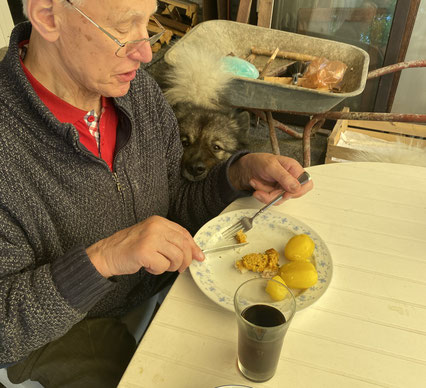
How can you tell if your dog is really getting the food? An indicator of a balanced diet is generally what solids the dog excretes. Of course, you should already know what these should look like and what they are like. The feces of a healthy dog should be firm to crumbly and have a dark black-brown color in the continuous part. If a lot of bone material is ingested, dry, hard, crumbly feces with a gray-white to yellow-gray color are formed. Light brown, soft or even mushy feces indicate a disorder in the digestive system - with one exception: a heavily pregnant dog always passes very soft feces, which has to do with the fact that the food pulp passes through the intestines more quickly, simply because there is not enough space in the body.
Now, about the change in food: what a drama it often becomes! It's so simple, because it's less about the ingredients/quality of the food, but rather about always giving the dogs something different, never offering just one or two types of industrial food, but really changing the food almost every day. Cheap food, expensive food, home-cooked food and sometimes something raw. Of course, such a strategy won't win you any friends among manufacturers and retailers. They are propagating something completely different - why? As a buyer, you alone have the power to make a manufacturer or your dog happy! Forget all the writing about supposed experts, question who hires and pays these people. The fairy tale about the complicated change in feed is a sophisticated dumbing down ploy - nothing more and nothing less. Just follow the simple principle of changing the type of food several times a week, and you will see that “changing your food” is the easiest thing in the world:
- Bowl empty = type 1 in
- Bowl empty = type 2 in
- Bowl empty = type 1, 2, 3 in
If you don't want to believe it, I recommend trying it yourself: Eat only sauerkraut for 7 days in a row, add a little water and you're good. After these 7 days, allow yourself a good portion of “solid food” and wait to see what happens. It won't take long before you'll get a diarrhea as f***. Why? Sauerkraut is super healthy! Yes, exactly. Just as healthy and digestible as the ready-made food XYZ is. But if you overdo it, it destroys the diversity of the intestinal flora - and you will see, smell and hear what that means. So much for healthy eating. 😜
Puppy's diet
Puppies need supplements to cooked meat, cooked carrots and the carbohydrate content of their food to keep them full. And this continues until they are fully grown. A balanced mixed diet with added vitamins and minerals promotes the harmonious growth of fur, teeth, bones and muscles. This also helps you avoid intolerances that make feeding extremely difficult.
Pasta and bread, rice and potatoes, i.e. carbohydrates, make you feel full and relaxed. The protein content is provided by boiled eggs, quark, mild cheese, yogurt and of course cooked beef, pork, chicken or turkey. The cooked carrots are responsible for fiber. The additives required for puppies and young dogs are added to the food as a finished mineral mixture based on kilograms of body weight. The protein content in puppy food should be 40%, the carbohydrate content is also 40%. The raw fiber content only makes up 5%, and fats make up another 5%. It is important that the proportion of calcium to phosphorus is approximately 1.3:1. Phosphate levels that are too high can gradually become harmful.
You should also make sure that the puppy tries all kinds of food. Unfortunately, the myth is still circulating that it is best to feed a single (dry) food until the 6th month (or worse: longer that up to the 6th month). Of course, this is terribly one-sided and only ensures that the puppy does not develop any food tolerances and may later be prone to intolerances. However, if the puppy's diet is completely changed overnight, intolerances may occur. Therefore, to be on the safe side, you should change the food - gradually over a period of a whole week, which allows the intestines to get used to the new food.
By the way, it's always red alert if puppies have diarrhea and/ or vomiting, as they can dehydrate and die in an instant. Experiments with animal charcoal, nonsense herbal mixtures, buttermilk and healing clay are strictly not recommended here anyway, especially if you have no idea about them. The vet should be consulted immediately.
Nutrition on diarrhea and vomiting
Every dog will usually experience some episodes of diarrhea over the course of their life. That's not a big deal, as long as the diarrhea or vomiting can be stopped. Dogs, like humans, have a so-called intestinal barrier, which is formed by the intestinal wall. This separates the inside of the intestine from the rest of the body, so to speak, but is still permeable, i.e. semi-permeable. This means that the intestinal wall prevents the chewed bread from floating around inside the body after breakfast. This intestinal barrier now copes with the mammoth task of deciding, almost every second, which substances from the ingested food are allowed to enter the body and which substances are immediately excreted. Nutrients and water are allowed to pass through, but bacteria, parasites and viruses remain in the intestine.
When you have diarrhea - and what we mean here is real diarrhea, not mushy feces - the intestinal barrier is inflamed and therefore permeable to particles or liquids. If the intestinal barrier is inflamed, the so-called “tight junctions” are restricted in their function and leak. Particles can flow from the intestines into the inside of the body, as well as from the blood into the intestines. That doesn't just sound unhealthy, it is. The resulting increase in inflammation makes the tight junctions more permeable, and there is a risk of a vicious cycle developing.
The natural and only correct reaction to this is usually instinctive by the dog and is to stop eating food completely. The dog should therefore be put on a diet for at least 24 hours without any food to give the intestines a break and to give the immune system a chance to get the disease under control. In addition, the zero diet deprives the pathogens of their nutritional basis and essentially starves them out. Under no circumstances should you try to persuade the dog to eat if he doesn't want to eat anything!
Again: The tight junctions have become leaky, so in addition to pests such as viruses and bacteria, undigested food molecules are now entering the body. These nutrient molecules - which are still too large due to the lack of digestion - are classified by the immune system as hostile because they cannot be assigned, and you have sensitization. If this food is then consumed again, problems such as food allergies are inevitable. Therefore, stay away from dubious tips from any online forums! If your dog is instinctively sound (and not a Labrador or Beagle by chance), he will refuse to eat anyway. So you don't need to do anything except wait for at least 24 hours. And by the way, zero diet really means zero, i.e. nothing but water. Nothing at all. Not a shred of food. You can then slowly start feeding by a light diet, giving very small amounts at first and then increasing it every hour.
The classic light diet for diarrhea:
- Fish or chicken breast fillet
- Carrots
- Water
- rice
- a bit of salt
Peel and dice carrots. Wash the rice and let it simmer for about an hour, together with two pinches of salt (you add salt because the rice otherwise removes too much water from the body). Cook the fish or chicken breast separately and, if necessary, strain it through a sieve and mix it with the carrot rice porridge. At the beginning, only feed spoonfuls every hour; the amount of food can be increased each time. You can also use stale rolls instead of rice, as these are usually tolerated without any problems. Fish, on the other hand, is generally better tolerated than chicken because it is easier to digest.
Moro carrot soup:
- a pound of carrots
- a teaspoon of salt
- Water
Peel and dice the carrots and let them boil in a liter of water for at least an hour. Strain the water and purée the carrots or strain them through a sieve. Pour water into a liter of soup and add the salt.
Moro carrot soup for the lazy:
- Buy organic carrot purée for small children. Dilute. Complete. 😎
The soup really helps, especially with pure diarrhea, as it absorbs the toxins from the intestines. If the dog is vomiting, you should really make sure that very little carrot soup is given at the beginning until you can see whether everything will stay inside.
Depending on the severity of the diarrhea and the corresponding loss of electrolytes, you can give a rehydration solution during the fasting phase (e.g. "Oralade"). Furthermore, the medicine cabinet should always contain aids such as "Diarsanyl" or "Canicur". In my experience, these support the restoration of the intestinal flora and the intestinal barrier absolutely reliable and stop diarrhea immediately.
Another old home remedy and a real insider tip against diarrhea are dried wild blueberries, but only the small, original ones in pharmacist quality, 100 grams cost around 10 euros. Even at the slightest sign of mushy stool, three to four berries can be given to prevent the situation from becoming acute in the first place. The berries must be chopped up with a knife in advance so that they don't simply pass through the dog's intestines whole. People chew the berries, dogs then get them chopped up. The tannins in the berries bind harmful intestinal bacteria, stop diarrhea and accelerate healing of the inflamed intestinal mucus. The inconspicuous berries really help tremendously - and not just dogs, but people too.
Conclusion
Before you buy into anything or believe the nonsense from the many, many online blogs, you should get the latest specialist literature and also rely on your common sense. And a good book about dieting a dog, is definitely cheaper than a visit to the vet ;-)
Avoid these foods!
Corn
Corn can influence behavior in two ways: First, it has an extremely low tryptophan content, which is problematic for unstable, stressed or anxious dogs. For stressed, anxious and unstable dogs and for senior dogs, who usually also have a more easily excitable cortisol system, corn is about the best thing to eat. Thanks to an enzyme in the corn, it can also have a calming effect on hyperactive dogs. Be that as it may, on the one hand corn is cheap fattening food and on the other hand it has too many behavior-influencing properties that I don't want to mess with. That's why I steer clear of corn, which I don't eat myself for the reasons mentioned above. Unfortunately, corn is found in almost all types of dry food.
Soy
Soy contains phytoestrogens, i.e. female plant hormones. Although there are no studies on the effects of phytoestrogens on stud dogs in particular, I would nevertheless be very careful with them so as not to accidentally create a hormonal imbalance.
Xylitol or birch sugar
Xylitol better known as birch sugar, is deadly to dogs. Unfortunately, many dog owners are not aware of this fact. But Xylitol is not declared under its name everywhere, you should remember the E number E967. Birch sugar causes a very rapid, very high insulin release, which lowers the sugar level in the blood and can therefore lead to cramps, severe liver damage, even coma or death due to hypoglycemia. That's why you should pay close attention to what kind of human food you give your dog, as Xylitol is really everywhere.
Raw pork
Pigs are sometimes carriers of the Aujeszky virus, which does not harm them, but causes a fatal disease in a carnivore, called pseudorage. After a very short incubation of a few days, the disease breaks out and inevitably leads to death, not only in dogs but also in cats. In contrast to wild boars, the German domestic pig population has been free of Aujeszky viruses for many years, so the likelihood of infection is much lower. This virus is killed at 60-70 degrees Celsius, so it only poses a danger in raw meat. When preparing wild boar meat, however, you should definitely ensure that the strictest hygiene is exercised so that dogs and cats cannot come into contact with it under any circumstances.
Calcium carbonate
Since calcium carbonate neutralizes stomach acid and can therefore indirectly trigger fermentation processes during digestion, which in turn can contribute to the dreaded gastric torsion, I would rather recommend calcium diphosphate as a dietary supplement.
Sources:
Zentek; Bela F. Wolf; Gudrun Beckmann, Erhard Oeser, Daniela Pörtl
12.03.2024
